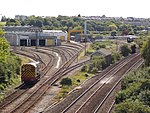Fort Efford

Fort Efford is a former 19th-century Fort, built as a result of the Royal Commission on National Defence of 1859. It was built to defend the landward approaches to the North East of Plymouth. This was part of an overall scheme for the defence of the Royal Naval Dockyard at Devonport, Plymouth. They were known as Palmerston Forts after the Prime Minister who championed the scheme. Designed by Captain (later Maj General) Edmund Frederick Du Cane, it was built by George Baker and Company and finished by the Royal Engineers. It was armed with 21 guns, some of which flanked the nearby Laira Battery. To house part of the Forts' Garrison a barrack block to house five officers and 108 men was built within the rear section of the Fort. In the 1890s a moveable armament shed was built on the parade ground to house two 5-inch Breech Loading guns. By the early 1900s the Fort had become obsolete as a defensive position and was disarmed. During the Second World War it was used for ammunition storage. It was sold by the War Office in 1961. It was Grade II listed in 2003. It has been used for storage by the Showman's Guild for many years.
Excerpt from the Wikipedia article Fort Efford (License: CC BY-SA 3.0, Authors, Images).Fort Efford
Efford Road, Plymouth Higher Compton
Geographical coordinates (GPS) Address Nearby Places Show on map
Geographical coordinates (GPS)
| Latitude | Longitude |
|---|---|
| N 50.389167 ° | E -4.11 ° |
Address
Efford Road
Efford Road
PL3 6NF Plymouth, Higher Compton
England, United Kingdom
Open on Google Maps




